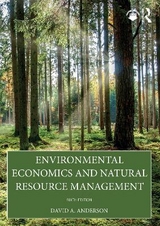
Environmental Economics and Natural Resource Management
Routledge (Verlag)
978-0-8153-5903-6 (ISBN)
The tools of environmental economics guide policymakers as they weigh development against nature, present against future, and certain benefits against uncertain consequences. The policies and research findings explained in this textbook are relevant to decisions made daily by individuals, firms, and governments.
This textbook offers instructors and students a user-friendly, relevant, and up-to-date introduction to these topics while covering recent advancements in the field and significant political and economic changes. The fifth edition has been thoroughly updated while retaining the story-based narratives and visual emphasis of previous editions, capturing students’ attention with full-color photos, graphs, and illustrations. It addresses the impact of changes in world leaders, national priorities, and international agreements along with key developments in the energy sector. These include the way hydraulic fracturing and the surging popularity of natural gas have revolutionized the fossil fuel industries; how new, green-energy technologies are bringing prices down and efficiency levels up; and the arrival of innovative energy sources such as ocean-thermal energy conversion.
Environmental Economics and Natural Resource Management promotes environmental and economic literacy with policy-oriented, application-based content, all delivered in concise, accessible discussions. Through its engaging approach, the text brings the economic way of thinking into discussions of personal, community, corporate, and government activities that affect environmental assets and the quality of life.
David A. Anderson is the Paul G. Blazer Professor of Economics at Centre College, Danville, Kentucky, USA. Dr. Anderson’s research focuses on the economics of the environment, law, crime, and public policy, and he has written 15 books including Survey of Economics, Explorations in Economics, and The Cost of Crime.
Part I Building a Foundation. 1. The Big Picture. 2. Efficiency and Choice. Appendix: Efficiency Criteria in Greater Detail. 3. Market Failure. 4. The Role of Government. 5. Trade-offs and the Economy. Part II Issues and Approaches. 6. Environmental Quality. 7. Energy. 8. Sustainability. 9. Population, Poverty, and Economic Growth. 10. Biodiversity and Valuation. 11. International and Global Issues. Part III Policy and Procedure. 12. Perspectives on Environmental Policy. 13. Natural Resource Management: Renewable Resources. 14. Natural Resource Management: Depletable and Replenishable Resources. Appendix: Intertemporal Allocation and Hotelling’s Rule. 15. Environmental Dispute Resolution. 16. Morals and Motivation
| Erscheinungsdatum | 10.01.2019 |
|---|---|
| Zusatzinfo | 15 Tables, black and white; 64 Line drawings, color; 107 Halftones, color; 171 Illustrations, color |
| Verlagsort | New York |
| Sprache | englisch |
| Maße | 189 x 246 mm |
| Gewicht | 1002 g |
| Themenwelt | Naturwissenschaften ► Biologie ► Ökologie / Naturschutz |
| Technik ► Umwelttechnik / Biotechnologie | |
| Wirtschaft ► Volkswirtschaftslehre | |
| ISBN-10 | 0-8153-5903-9 / 0815359039 |
| ISBN-13 | 978-0-8153-5903-6 / 9780815359036 |
| Zustand | Neuware |
| Haben Sie eine Frage zum Produkt? |
aus dem Bereich



